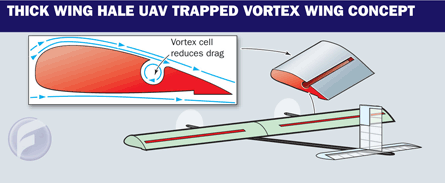In August a thick-wing concept that could be used for a radically different high-altitude long-endurance unmanned air vehicle will be tested in a Turin Polytechnic windtunnel.
A thick wing holds the prospect of providing a very large internal volume for fuel, giving a UAV an extremely long endurance capability while delivering adequate lift-to-drag for take-off and a higher lift coefficient that enhances endurance. Its developers think that for a UAV the thick wing's internal fuel volume and lift coefficient advantages outweigh traditional aircraft's performance parameters that demand highly optimised aerofoils.
"If the wing, that is yet to be designed, does have a 1.5m [4.9ft] span and a 60cm [23.6in] cord this might be full scale for a HALE UAV," says Sergei Chernyshenko, the Imperial College London aeronautics department chair in aerodynamics.
 |
|---|
The Turin tests follow subscale thick-wing windtunnel work at the Italian aerospace agency CIRA's facilities. Work carried out at the University of Southampton has confirmed that it is possible to predict the strength of the trapped vortex that is a feature of thick-wing design.
The vortex cell, a wing-wide cavity located towards the trailing edge, reduces drag from unsteady separation across the wing. The earlier windtunnel work involved testing geometries to investigate the best thick-wing shape to draw in the air vortices, which typically form over them, into this area that "traps" them. Adaptive systems for flows with trapped vortices have also been examined and will feature as part of the wing to be tested in Turin.
The work is being conducted for the European Union's sixth framework project VortexCell 2050. It has 10 partner organisations, including Russian battery manufacturer Rigel, Piaggio Aero Industries and the universities of Bordeaux, Eindhoven, Glasgow, Moscow and Munich.
Source: Flight International























